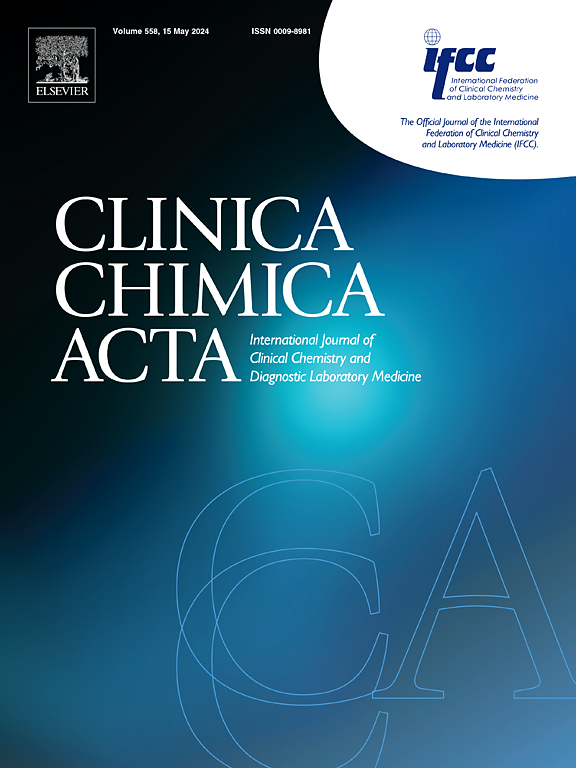The impact of urinary metal exposure on cardiac injury measured by four high-sensitivity troponin assays in US adults: A nationwide cross-sectional study
IF 2.9
3区 医学
Q2 MEDICAL LABORATORY TECHNOLOGY
引用次数: 0
Abstract
Background
Existing research primarily focuses on cardiovascular disease risks, with limited studies on the impact of metals on cardiac injury. This study aims to investigate the associations between urinary metal exposure and cardiac injury biomarkers, specifically high-sensitivity cardiac troponin I (Hs-cTnI) and T (Hs-cTnT), in US adults.
Methods
We analyzed data from 3,865 adults in the National Health and Nutrition Examination Survey (1999–2004) using weighted quantile sum (WQS) regression, quantile g-computation (Qgcomp), multivariate logistic regression, and Bayesian kernel machine regression (BKMR) to examine correlations between 9 urinary metals and cardiac injury biomarkers (Hs-cTnI and Hs-cTnT).
Results
Increased Abbott Hs-cTnI was significantly associated with higher levels of Cd (OR: 1.26, 95% CI: 1.11, 1.42) and lead (Pb) (OR: 1.17, 95% CI: 1.01, 1.34) in multivariate logistic regression. Furthermore, Cd (85.90%), Pb (8.01%), and tungsten (W) (3.34%) were the most weighted metals in the Abbott Hs-cTnI WQS models. For the Qgcomp model analysis of Ortho Hs-cTnI, Siemens Hs-cTnI, Abbott Hs-cTnI, and Hs-cTnT, the positive direction metal was Cd (0.2986, 0.6520, 0.7638 and 0.3648, respectively). Based on the results of BKMR, the components that had the highest conditional posterior inclusion probability of Hs-cTnT were Cd (1.000), and antimony (Sb) (1.000) among metal mixtures. Systolic blood pressure mediated the highest proportion of mediating effects in cardiac injury biomarkers.
Conclusion
Altogether, our findings indicate that exposure to a metal combination in the urine is associated with an increased risk of cardiac injury. Meanwhile, this association may be predominantly influenced by Cd.
美国成人尿金属暴露对心脏损伤的影响通过四种高灵敏度肌钙蛋白测定:一项全国性的横断面研究。
背景:现有的研究主要集中在心血管疾病的风险上,关于金属对心脏损伤影响的研究有限。本研究旨在调查美国成人尿金属暴露与心脏损伤生物标志物之间的关系,特别是高敏感性心肌肌钙蛋白I (Hs-cTnI)和T (Hs-cTnT)。方法:利用加权分位数和(WQS)回归、分位数g计算(Qgcomp)、多元逻辑回归和贝叶斯核机回归(BKMR)分析1999-2004年全国健康与营养调查中3865名成年人的数据,检验9种尿金属与心脏损伤生物标志物(Hs-cTnI和Hs-cTnT)之间的相关性。结果:在多因素logistic回归中,Abbott Hs-cTnI升高与较高的Cd (OR: 1.26, 95% CI: 1.11, 1.42)和铅(Pb) (OR: 1.17, 95% CI: 1.01, 1.34)水平显著相关。此外,在Abbott Hs-cTnI WQS模型中,Cd(85.90%)、Pb(8.01%)和钨(W)(3.34%)是权重最大的金属。对于Ortho Hs-cTnI、Siemens Hs-cTnI、Abbott Hs-cTnI和Hs-cTnT的Qgcomp模型分析,阳性方向金属为Cd(分别为0.2986、0.6520、0.7638和0.3648)。根据BKMR结果,Hs-cTnT条件后验包合概率最高的成分是金属混合物中Cd(1.000)和锑(Sb)(1.000)。在心脏损伤生物标志物中,收缩压介导的介导作用比例最高。结论:总之,我们的研究结果表明,暴露于尿液中的金属组合与心脏损伤的风险增加有关。同时,这种关联可能主要受Cd的影响。
本文章由计算机程序翻译,如有差异,请以英文原文为准。
求助全文
约1分钟内获得全文
求助全文
来源期刊

Clinica Chimica Acta
医学-医学实验技术
CiteScore
10.10
自引率
2.00%
发文量
1268
审稿时长
23 days
期刊介绍:
The Official Journal of the International Federation of Clinical Chemistry and Laboratory Medicine (IFCC)
Clinica Chimica Acta is a high-quality journal which publishes original Research Communications in the field of clinical chemistry and laboratory medicine, defined as the diagnostic application of chemistry, biochemistry, immunochemistry, biochemical aspects of hematology, toxicology, and molecular biology to the study of human disease in body fluids and cells.
The objective of the journal is to publish novel information leading to a better understanding of biological mechanisms of human diseases, their prevention, diagnosis, and patient management. Reports of an applied clinical character are also welcome. Papers concerned with normal metabolic processes or with constituents of normal cells or body fluids, such as reports of experimental or clinical studies in animals, are only considered when they are clearly and directly relevant to human disease. Evaluation of commercial products have a low priority for publication, unless they are novel or represent a technological breakthrough. Studies dealing with effects of drugs and natural products and studies dealing with the redox status in various diseases are not within the journal''s scope. Development and evaluation of novel analytical methodologies where applicable to diagnostic clinical chemistry and laboratory medicine, including point-of-care testing, and topics on laboratory management and informatics will also be considered. Studies focused on emerging diagnostic technologies and (big) data analysis procedures including digitalization, mobile Health, and artificial Intelligence applied to Laboratory Medicine are also of interest.
 求助内容:
求助内容: 应助结果提醒方式:
应助结果提醒方式:


